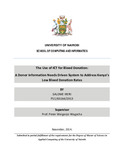The Use Of ICT For Blood Donation: A Donor Information Needs Driven System To Address Kenya’s Low Blood Donation Rates
| dc.contributor.author | Ireri, Salome | |
| dc.date.accessioned | 2016-05-01T11:00:00Z | |
| dc.date.available | 2016-05-01T11:00:00Z | |
| dc.date.issued | 2014-11 | |
| dc.identifier.uri | http://hdl.handle.net/11295/95396 | |
| dc.description.abstract | The gap between demand and supply of blood is continuously widening as the population increases. This is of great concern in Kenya where blood donation figures are below the World Health Organization‟s recommendations. A random cross-sectional survey involving 224 respondents was conducted in and around Nairobi. The objective of this study was to elicit donor information needs to enable the improvement of donor recruitment and retention strategies through the use of ICT based tools. 63.8% of respondents had never donated blood and only 4.9% were regular donors. Only 19 of the 81 donors had been contacted by the Kenya National blood Transfusion Service. 71.4 % of all respondents indicated that receiving SMS and emails with information on blood donation dates and venues would be quite useful, while 79% would welcome educative information on blood donation.70.1% of respondents suggested that increased awareness on donation dates and venues and increased donor education would improve donor participation. This survey identified information gaps present in the current National Blood Transfusion Service systems and in Kenya in general. There is very little use of ICTs to help improve blood donor participation. This research project aimed at not only identifying these gaps but also creating ICT based ways of filling in these gaps. A donor information needs oriented prototype system was therefore designed and developed. It was then tested with the aim of finding out if it was meeting the identified donor information needs. 85% of the respondents of this test strongly agreed that they appreciate receiving a donor registration confirmation and a thank you note via SMS immediately after donation. 75% of the respondents indicated they very much welcomed receiving SMS notifications with useful information on when and where to collect their donor card and blood test results. While over 70% of the participants indicated that they found SMS messages with donation dates and venues and educative information useful and motivating. 55% strongly agree that the probability that they are more likely to donate after receiving the donation notifications and educative information is high. Based on these test results, the registered donors appreciate receiving notifications and educative SMS messages through this system and are now more likely to attend donation drives and donate and share the knowledge they receive with friends and family | en_US |
| dc.language.iso | en | en_US |
| dc.publisher | University of Nairobi | en_US |
| dc.subject | The Use Of ICT For Blood Donation | en_US |
| dc.title | The Use Of ICT For Blood Donation: A Donor Information Needs Driven System To Address Kenya’s Low Blood Donation Rates | en_US |
| dc.type | Thesis | en_US |

